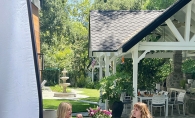Scott Crosbie remembers being 8 years old, standing on the street corner and waiting for the band to march down the street. Edina’s Memorial Day parades during the 1960s were an inspiration to the boy who later became the director of Edina’s John Philip Sousa Memorial Band. Since kids weren’t exposed to much cinematic magic and entertainment at the time, “when [the band] came by with the brass and the big drums and sparkling woodwinds, it was something to get excited about,” recalls Crosbie. The spirit of parades is still alive and well in Edina, and this year the Sousa Band will continue the tradition by riding on a float for the city’s 125-year celebration. The big Fourth of July Quasquicentennial Parade is appropriately themed for the history of Edina, which happens to be rich in parades and celebrations harking back to the city’s early days. 1930: Edina’s First Parade Before Edina was a bustling city with businesses, fine dining and traffic lights, it was a simple farming community. In fact, when Edina officially broke off from Richfield in 1888, it felt more like a village than a city. But that didn’t stop the community from gathering for celebrations. On July 4, 1930, Edina’s first known parade was held at the Edina Country Club. Volunteer firefighters, ladies dressed in 19th century period costume, the owner of the Edina Mill, and other original pioneers paid tribute to their young town by riding on floats and marching down the street. Three-legged races, fireworks and birthday cake were also part of the Fourth of July tradition that continued for about 10 years, until the Second World War turned the city’s attention elsewhere. Post-World War II: Memorial Day Parade Parades were not completely forgotten during the post-war years. Impromptu community parades became a way of celebrating soldiers homecomings or other city accomplishments. Edina Historical Society board member and lifelong resident Frank Cardarelle remembers when a new fire truck in town was cause for celebration. His brother, who was a volunteer firefighter at the time, got to ride in the truck that sparked Edina’s first Memorial Day Parade. “It wasn’t very big, but it was a parade,” says Cardarelle. From the late ’40s to the late ’60s the annual Memorial Day Parade, sponsored by the American Legion, was a time to gather as a community and honor veterans. It wasn’t so much about pomp and circumstance, juggling acts and fancy floats as it was a simple tribute to the men who served, says Marci Matson, director of the Edina Historical Society. Ed Melichar, who was the high school band director in the ’60s, felt honored to lead the parade. “I was always glad to march alongside the kids. It was a wonderful experience,” he says. In the late ’60s the legion handed responsibility for the parade to the city, and shortly thereafter the holiday began to be celebrated on a Monday, and parade turnouts declined. 1951: Edina High School’s First Homecoming Parade Edina High School graduated its first high school class in 1951, and with such an accomplishment came the city’s first homecoming parade. Although the class, which included Cardarelle, consisted of only 112 students and its route was a simple loop around the track, the parade marked the start of a new tradition that continues today. High school seniors now take to the streets with their homecoming entourage and march the official parade route. 1970: Edina’s Original ‘Flash Band’ When Crosbie graduated from Edina High in 1970, he wasn’t ready to say goodbye to the marching band. So he and a few buddies drove to Buffalo and purchased 50 old band uniforms for $3 apiece. Since they were young and without any real connections to concert venues, they simply packed up their cars, drove out to a surrounding suburb like Chaska, and began marching around the streets and parks. “It was like the original flash band,” says Crosbie. People started following them around and even the cops helped out the band. “We were crashing the town and it was fun,” he says. Today the band performs at official venues such as Edinborough Park, and looks forward to being a part of the annual Fourth of July Parade. 1988: The Centennial Parade One hundred years is a milestone Edina didn’t let pass by without a celebration—or a parade. Betty Hemstad and Kay Bach co-chaired the centennial year celebration and appointed 40 commissioners to lead different activities throughout the year. Naturally, the Fourth of July event was one of the biggest; it coincided with the band and all-school reunion, so the city had the makings for an impressive parade. Not only did the band march down the streets of Edina, there were floats for community groups, a horse-drawn carriage for the mayor and his wife; even Cardarelle’s mother rode in a car as an honorary citizen. Hemstad recalls that one of the highlights was city manager Ken Rosland, who dressed as a clown to follow the horses as the official “pooper scooper.” There was also a separate kiddie parade that involved bikes, costumes and a bagpiper leading the way. “It was a community grass-roots organization run by residents,” says Mary Brindle, former parade committee member, so although the parade was a big success, for the next decade it was an informal, low-key event. 1998: The Parade Gets a Makeover When Gordon Hughes stepped into the role of city manager in ’98, the city appointed a special parade committee. For the first time, Edina had a budget to bring in marching bands and help grow the parade. Brindle and Crosbie, who were both involved in this stage, are proud of the results. Today Edina’s annual parade draws 15,000 to 20,000 people, involves 1,000 participants and 90 units, but never lasts more than an hour and a half. As Brindle points out, a short parade is key. Since the route is only a mile and a half, bands can perform the entire time, which is something you don’t get with larger parades. “It’s very organized and very controlled,” says Brindle. John Swon, who is parade chair this year, credits the people before him who turned the parade into a well-oiled machine. “They’ve been able to hand off a blueprint of how to [orchestrate] the event, which makes it very easy and a joy to take over,” says Swon. 2013: Quasquicentennial This year Edina is continuing the tradition of parades and honoring its history with the theme “Edina: Making History Since 1888.” Besides the elaborate floats, marching bands and patriotic flair, there’s something else that excites Crosbie. “When I see all kinds of people in all walks of life and nationalities coming down the street on the same road, heading in the same direction with confidence, it’s like a microcosm of what this country is; it’s a validation of the American family,” says Crosbie. For a city that prides itself on its diverse achievements, solid schools and social acclaim, there’s no better road to be walking down together. & History Happened Here photo exhibit; opens in June Historic Home Tour, Sept. 15; $15 in advance, $20 at the door Founders’ Day Celebration, Dec. 12, City Hall edinahistoricalsociety.org
Menu
From the June 2013 issue
Edina Celebrates the Quascquicentennial
In honor of the quascquicentennial, a look back at Edina’s parades.
Photo by:
The City of Edina









